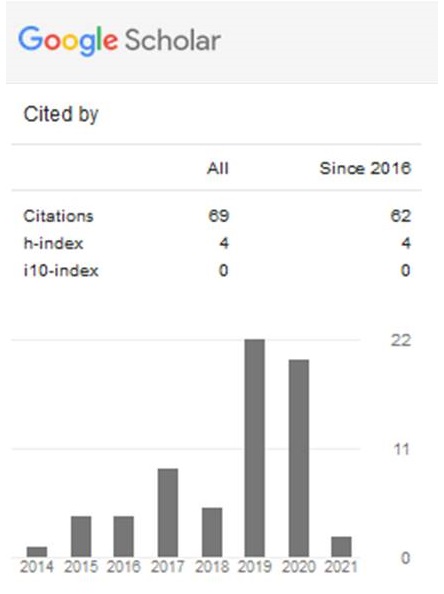Pengaruh Pemberian Kompos TKKS dan Pupuk MKP terhadap Pertumbuhan Dan Produksi Tanaman Kacang Tanah (Arachis hypogaea L)
Abstract
Keywords
Full Text:
PDF (Bahasa Indonesia)References
Affriliyanto. B., Oktarina., dan W. Widiarti. 2015. Optimasi Produksi Tanaman Kacang Tanah (Arachis hypogaea, L.) Melalui Pemberian Pupuk Mono Kalium Phospat Dan Zat Pengatur Tumbuh. Fakultas Pertanian Universitas Muhammadiyah Jember. Jember.
Aminuddin, M. I. 2017. Respon pemberian pupuk mkp dan jarak tanam terhadap pertumbuhan dan produksi cabai rawit (Capsicum frustescens L.). AGRORADIX : Jurnal Ilmu Pertanian. 1 (1) : 44-59.
Andri S., Nelvia, Saputra, S, I. 2016. Pemberian Kompos Tkks dan Cocopeat Pada Tanah Subsoil Ultisol Terhadap Pertumbuhan Bibit Kelapa Sawit (Elaeis guineensis Jacq.) di Pre Nursery. Jurnal Agroteknologi, vol. 7 (1) : 1 – 6.
Badan Pusat Statistik. 2020. Data Produksi Tanaman Pangan seluruh Provinsi di Indonesia.www.bps.go.id/tnmn_pgn.php. Diakses tanggal 03 Oktober 2020.
Cibro, M. A. 2008. Respon Beberapa Varietas Kacang Tanah (Arachis hypogaea L.) Terhadap Pemakaian Mikoriza Pada Berbagai Cara Pengolahan Tanah. Universitas Sumatera Utara. Medan.
Darnoko, D., dan T. Sembiring. 2005. Sinergi antara perkebunan kelapa sawit dan pertanian tanaman pangan melalui aplikasi kompos TKKS untuk tanaman padi. Medan.
Dinas Ketahanan Pangan Provinsi Riau. 2019. Data Kebutuhan Kacang Tanah. https://diskepang.riau.go.id. Diakses bulan Oktober 2019.
Djuarnani., N. Kristian., dan B. S. Setiawan. 2005. Cara Cepat Membuat Kompos. Agro Media Pustaka. Depok.
Gardner F. P., R. B. Pearce dan R. L. Mitchell. 1991. Fisiologi Tanaman Budidaya. Universitas Indonesia. Jakarta.
Hairiah, K. 2000. Pengolahan Tanah Masam Secara Biologi. ICRAF. Bogor.
Harjadi. 1980. Pengantar Agronomi. PT Gramedia. Jakarta.
Jumin. H. B. 2005. Ekologi Tanaman Suatu Pendekatan Fisiologis. Rajawali Press. Jakarta.
Kamil, J. 1982. Teknologi Benih. Penebar Angkasa Raya. Padang.
Lakitan, B. 2003. Fisiologi Pertumbuhan dan Perkembangan Tanaman. Raja Grafindo Persada. Jakarta.
Lakitan, B. 2015. Dasar-Dasar Fisiologi Tumbuhan. PT Raja Grafindo Persada. Jakarta.
Marzuki, R. 2009. Bertanam Kacang Tanah. Penebar Swadaya. Jakarta.
Munawar, A. 2011. Kesuburan Tanah dan Nutrisi Tanaman. IPB Press. Bogor.
Novizan. 2002. Petunjuk Pemupukan yang Efektif. Agromedia Pustaka. Jakarta.
Pusat Penelitian dan Pengembangan Perkebunan. 2016. Pemanfaatan Tandan Kosong Limbah Sawit sebagai Pupuk Organik. Warta Penelitian dan Pengembangan Industri. 22(1): 1-32.
Sahputra, N., A. E. Yulia., dan F. Silvina. 2016. Pemberian Kompos Tandan Kosong Kelapa Sawit dan Jarak Tanam Pada Kedelai Edemame (Glycine max L.). Jurnal Jom Faperta. 3(1):1-12.
Sembiring, M., R. Sipayung., dan F. E. Sitepu. 2014. Pertumbuhan dan produksi kacang tanah dengan pemberian kompos tandan kosong kelapa sawit pada frekuensi pembumbunan yang berbeda. Jurnal Online Agroteknologi. Vol 2 (2).
Sutedjo, M. 2002. Pupuk dan Cara Pemupukan. Rineka Cipta. Jakarta.
Syukri, A., Nelvia., Adiwirman. 2019. Aplikasi Kompos Tandan Kosong Kelapa Sawit Dan Pupuk Npkmg Terhadap Sifat Kimia Tanah Ultisol Dan Kadar Hara Daun Kelapa Sawit (Elaeis guineensis Jacq). Jurnal Solum, vol 16 (2) : 49 – 59.
Wijaya, K. A. 2020. Nutrisi Tanaman. Penerbit Andi. Yogyakarta.
Refbacks
- There are currently no refbacks.

_2017.jpg)



